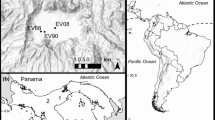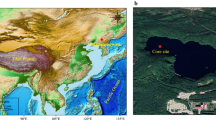Abstract
The termination of the African Humid Period in northern Africa has been described as abrupt, occurring within centuries, as well as gradual, in response to incremental decreases in summer insolation. This study examined the rapidity of the change in diatom assemblages over the period from 6.5 to 4.5 cal ka BP, in a core studied previously at a coarser resolution. This transition was characterized by high variability of assemblages, which could be related, in part, to changes in water conductivity, and potentially enhanced by a site-specific hydrological threshold or ecological salinity threshold. We hypothesize that the variations in diatom assemblages reflect climate fluctuations, which may have been an early warning signal of an impending climate regime shift.






Similar content being viewed by others
References
Ayenew T (2007) Water management problems in the Ethiopian rift: challenges for development. J Afr Earth Sci 48:222–236
Battarbee R, Juggins S, Gasse F, Erson NJ, Bennion H, Cameron NG (2000) European Diatom Database Initiative (EDDI). http://craticula.ncl.ac.uk/Eddi/jsp/index.jsp
Burrough SL, Thomas DSG (2013) Central southern Africa at the time of the African Humid Period: a new analysis of Holocene palaeoenvironmental and palaeoclimate data. Quat Sci Rev 80:29–46
Carstensen J, Telford RJ, Birks HJB (2013) Diatom flickering prior to regime shift. Nature 498:E11
Chalié F, Gasse F (2002) Late Glacial–Holocene diatom record of water chemistry and lake level change from the tropical East African Rift Lake Abiyata (Ethiopia). Palaeogeogr Palaeoclimatol Palaeoecol 187:259–283
Cocquyt C (1998) Diatoms from the northern basin of Lake Tanganyika. Bibliotheca Diatomologica 39, Stuttgart, 275 pp
Dakos V, Scheffer M, van Nes EH, Brovkin V, Petoukhov V, Held H (2008) Slowing down as an early warning signal for abrupt climate change. Proc Natl Acad Sci USA 105:14308–14312
David WR (2016) labdsv: ordination and multivariate analysis for ecology. R package version 1.8-0. https://CRAN.R-project.org/package=labdsv
deMenocal P, Bond G (1997) Holocene climate less stable than previously thought. EOS Trans Am Geophys Union 78:447–454
deMenocal P, Ortiz J, Guilderson T, Adkins J, Sarnthein M, Baker L, Yarusinsky M (2000) Abrupt onset and termination of the African Humid Period: rapid climate responses to gradual insolation forcing. Quat Sci Rev 19:347–361
Ellis N, Smith SJ, Pitcher CR (2012) Gradient forests: calculating importance gradients on physical predictors. Ecology 93:156–168
Foley JA, Coe MT, Scheffer M, Wang GL (2003) Regime shifts in the Sahara and Sahel: interactions between ecological and climatic systems in northern Africa. Ecosystems 6:524–539
Gasse F (1986) East African diatoms: taxonomy, ecological distribution. Bibliotheca Diatomologica 11. Cramer, Berlin, 201 pp
Gasse F (2001) Paleoclimate-hydrological changes in Africa. Science 292:2259–2260
Gasse F, Juggins S, Ben Khelifa L (1995) Diatom-based transfer functions for inferring past hydrochemical characteristics of African Lakes. Palaeogeogr Palaeoclimatol Palaeoecol 117:31–54
Gibert E, Travi Y, Massault M, Chernet T, Barbecot F, Laggoun-Defarge F (1999) Comparing carbonate and organic AMS-14C ages in Lake Abiyata sediments (Ethiopia): hydrochemistry and paleoenvironmental implications. Radiocarbon 41:271–286
Gillespie R, Street-Perrott FA, Switsur R (1983) Post-glacial arid episodes in Ethiopia have implications for climate prediction. Nature 306:680–683
Hammer UT (1986) Saline Lake ecosystems of the world. Monographiae Biologicae, XI, Springer, Netherlands, 616 pp
Hustedt F (1949) Exploration du Lac National Albert: Süsswasser Diatomen aus dem Albert-National Park in Belgisch-Kongo. Mission H. Damas (1935–36), Brussels, 199 pp
Juggins S (2013) Quantitative reconstructions in palaeolimnology: new paradigm or sick science? Quat Sci Rev 64:20–32
Krammer K, Lange-Bertalot H (1986) Süsswasserflora von Mitteleuropa. Bacillariophyceae 1. Teil: Naviculaceae. VEB Gustav Fisher Verlag, Jena
Krammer K, Lange-Bertalot H (1988) Süsswasserflora von Mitteleuropa. Bacillariophyceae 2. Teil: Bacillariaceae, Epithemiaceae, Surirellaceae. VEB Gustav Fisher Verlag, Jena
Krammer K, Lange-Bertalot H (1991a) Süsswasserflora von Mitteleuropa. Bacillariophyceae 3. Teil: Centrales, Fragilariaceae, Eunotiaceae. VEB Gustav Fisher Verlag, Jena
Krammer K, Lange-Bertalot H (1991b) Süsswasserflora von Mitteleuropa. Bacillariophyceae 4. Teil: Achnanthaceae, Kritische Ergänzungen zu Navicula (Lineolatae) und Gomphonema Gesamtliteraturverzeichnis Teil 1-4. VEB Gustav Fisher Verlag, Jena
Kröpelin S, Verschuren D, Lézine AM, Eggermont H, Cocquyt C, Francus P, Cazet JP, Fagot M, Rumes B, Russell JM, Darius F, Conley DJ, Schuster M, von Suchodoletz H, Engstrom DR (2008) Climate-driven ecosystem succession in the Sahara: the past 6000 years. Science 320:765–768
R Core Team (2016) R: a language and environment for statistical computing. R Foundation for Statistical Computing, Vienna. https://www.R-project.org/
Roubeix V, Danis PA, Feret T, Baudoin JM (2016) Identification of ecological thresholds from variations in phytoplankton communities among lakes: contribution to the definition of environmental standards. Environ Monit Assess 188:246. https://doi.org/10.1007/s10661-016-5238-y
Scheffer M, Carpenter SR (2003) Catastrophic regime shifts in ecosystems: linking theory to observation. Trends Ecol Evol 18:648–656
Seddon AWR, Froyd CA, Witkowski A, Willis KJ (2014) A quantitative framework for analysis of regime shifts in a Galapagos coastal lagoon. Ecology 95:3046–3055
Stuiver M, Reimer PJ (1993) Extended C-14 data-base and revised Calib 3.0 C-14 age calibration program. Radiocarbon 35:215–230
Stuiver M, Reimer PJ, Bard E, Beck JW, Burr GS, Hughen KA, Kromer B, McCormac G, Van der Plicht J, Spurk M (1998) INTCAL98 radiocarbon age calibration, 24,000-0 cal BP. Radiocarbon 40:1041–1083
Telford RJ, Lamb HF (1999) Groundwater-mediated response to Holocene climatic change recorded by the diatom stratigraphy of an Ethiopian crater lake. Quat Res 52:63–75
ter Braak CJF, Looman CWN (1986) Weighted averaging, logistic regression and the Gaussian response model. Vegetatio 65:3–11
Thomas ZA (2016) Using natural archives to detect climate and environmental tipping points in the earth system. Quat Sci Rev 152:60–71
Tierney JE, deMenocal PB (2013) Abrupt shifts in Horn of Africa hydroclimate since the last glacial maximum. Science 342:843–846
Walker B, Meyers JA (2004) Thresholds in ecological and social-ecological systems: a developing database. Ecol Soc 9(2):3. http://www.ecologyandsociety.org/vol9/iss2/art3
Wang R, Dearing JA, Langdon PG, Zhang EL, Yang XD, Dakos V, Scheffer M (2012) Flickering gives early warning signals of a critical transition to a eutrophic lake state. Nature 492:419–422
Acknowledgements
We thank Jean-Charles Mazur (CEREGE) for slide preparation of the new analyzed samples. Sediment core samples were collected under the auspices of CNRS-INSU Programs PNEDC-ERICA (‘Environmental Research for Intertropical Climate in Africa’, R.Bonnefille, coord.), and ECLIPSE-CLEHA (‘CLimat, Environnement et dynamique des populations Humaines en Afrique de l’Est depuis 20,000 ans’, D. Williamson coord.). We are grateful to Keely Mills for valuable comments and suggestions that greatly improved the manuscript, and to an anonymous reviewer for helpful comments.
Author information
Authors and Affiliations
Corresponding author
Rights and permissions
About this article
Cite this article
Roubeix, V., Chalié, F. New insights into the termination of the African Humid Period (5.5 ka BP) in central Ethiopia from detailed analysis of a diatom record. J Paleolimnol 61, 99–110 (2019). https://doi.org/10.1007/s10933-018-0047-7
Received:
Accepted:
Published:
Issue Date:
DOI: https://doi.org/10.1007/s10933-018-0047-7




